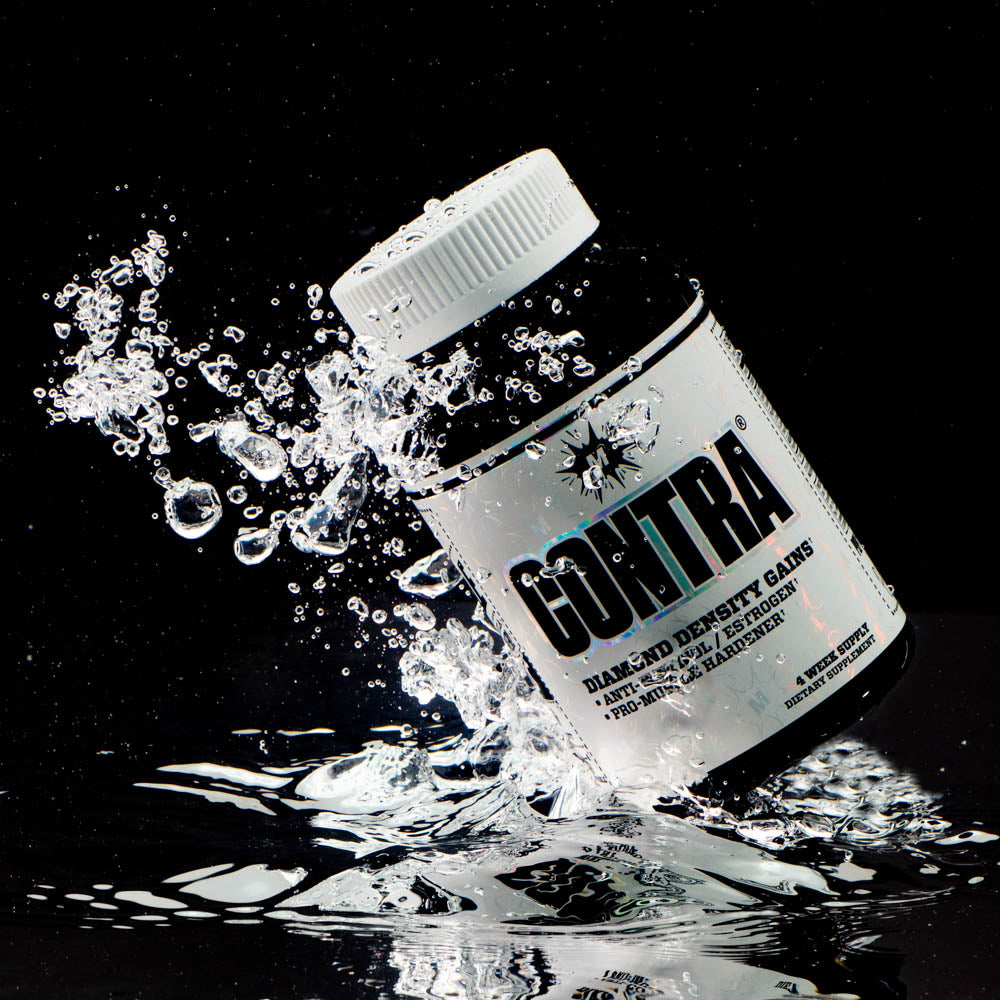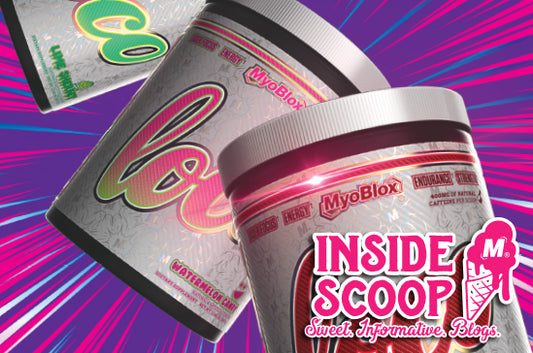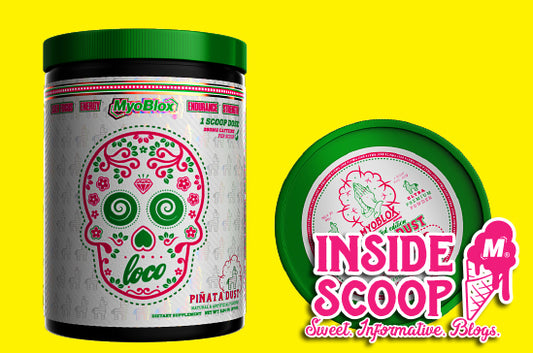
CONTRA®: BEHIND THE LABEL
Contra is a premium, highly potent supplement that has been shown to not only increase natural testosterone production, but also inhibit/correctively balance cortisol levels to maximize your body's anabolic state. Contra also includes a strong aromatase inhibitor to prevent any unwanted estrogenic side effects and maintain a lean physique. The goal of this article is to explain the key ingredients in Contra and how to use the product most efficiently.
Ashwagandha (as KSM-66®): Ashwagandha is an Ayurvedic adaptogen that is mostly used to combat stress and increase fertility. It is so highly touted that it is often called the "King of Ayurveda" and oddly translates to "smell of horse." The main active compounds in ashwagandha are called withanolides, which are steroidal lactones found in the root of the plant.1 KSM-66® is standardized to 5% withanolides, but also keeps the exact ratios of withanolides that naturally occur in the plant. Ashwagandha has tons of health benefits, but for the purpose of this article, I will focus on its ability to decrease cortisol and increase testosterone levels. Cortisol is a catabolic hormone released from your adrenal glands during periods of stress. While in small amounts it can be beneficial (fight or flight), prolonged elevated levels are more conducive to storing bodyfat and breaking down muscle tissue.
KSM-66® might be the most effective herb at lowering serum cortisol levels in humans. In a study involving 52 healthy men and women, subjects given 300mg of KSM-66 twice daily for 8 weeks saw a 22.2% decrease in serum cortisol levels vs baseline values. The same study also yielded a 3% decrease in bodyweight, almost double compared to the placebo, along with a 2.9% decrease in BMI.2 Another study using KSM-66® had 64 participants (men and women) receive either 300mg twice daily of KSM-66 or a placebo for 60 days, with serum cortisol levels checked every 15 days. The KSM group noticed a 44% decrease in perceived stress, a 76% decrease in anxiety, as well as a 27.9% decrease in serum cortisol levels.
KSM-66® is also an excellent testosterone-boosting supplement. In a study involving 180 hypogonadic men, subjects given 5g/d of raw ashwagandha for 3 months showed an increase of up to 22%.3 Another study in 57 healthy males(average starting testosterone levels of 630ng/dL) given 300mg or KSM-66® twice daily for 8 weeks showed a 15% increase in total testosterone levels(the placebo only saw a 2.5% increase). Researchers also noticed a significant increase in 1RM bench press and leg extension, as well as a 3.5% decrease in body (the placebo only dropped 1.5%).4 Ashwagandha has even been shown to increase sexual function, libido, desire, and fertility in women.5 Typical doses of raw ashwagandha are up to 5g of root a day, and 600mg of standardized formulas like KSM-66®.
3,3'-Diindoylylmethane(DIM): DIM is the main active metabolite of indole-3-carbinol, which is found in many cruciferous vegetables including brussel sprouts, turnips, kale and cabbage. The main mechanism of action for DIM is two-fold: it can, in low doses act as an aromatase inhibitor preventing the conversion of testosterone to estrogen (however in high doses can have the opposite effect), and it can modify potent estrogens into healthier estrogens via selectively hydroxylating certain parts of the estrogen molecule.6 For example, 4-hydroxyestradiol is a very potent estrogen that can cause gynecomastia in men. DIM metabolized estradiol into the less potent 2-hydroxy estrone, which is then eliminated. DIM also binds to the aryl hydrocarbon receptor (AhR) which causes a downregualtion of estrogen receptor production. Some studies show that a metabolite of 2-hydroxyestrone, 2-methoxyestradiol can even help displace testosterone that is bound to sex hormone binding globulin (SHBG) to increase free testosterone levels. This is due to 2-methoxyestradiol's high affinity to SHBG.7 Interestingly, 2-hydroxyestradiol is not suppressive to the HTPA where 4-hydroxyestradiol is. This may also indirectly increase testosterone levels.8 Typical doses of DIM are between 100-300mg daily.
N-Coumaroyldopamine: N-coumaroyldopamine is a naturally occurring beta-2 adrenergic receptor agonist that is extracted from Theobroma cacao. Beta-2 agonists are the most effective mechanism for inducing fat loss in humans. Some examples for strong beta-2 agonists are ephedrine and clenbuterol. Inside the body, N-coumaroyldopamine gets broken down into dopamine. Due to its structure, it is highly selective to specifically the beta-2 receptor, not beta-1 which is responsible for the heart palpitations and sjdablffb. N-coumaroyldopamine works by increasing the messenger molecule cyclic adenosine monophosphate (cAMP). cAMP activates a process called lipolysis, which is when your cells release fatty acids to be burned as energy.9 Elevated levels of cAMP have also been associated with increased vasodilation, increased metabolic rate and energy expenditure.
Beta-2 adrenergic receptors can also have an anabolic effect in muscle tissue and even have been used in the treatment of muscle wasting diseases like sarcopenia and cachexia.10 Typical daily doses of N-coumaroyldopamine have not been established, but seems to have an effect in the 20-40mg/d range.
Androsta-3,5-diene-7,17-dione: Androsta-3,5-diene-7,17-dione is a naturally occurring metabolite of 7-keto-DHEA that acts as an aromatase inhibitor in the body. Aromatase is the enzyme that converts testosterone to estrogen. Due to its chemical structure, it has a pretty high affinity to the aromatase receptor, with a Ki value (how strongly a molecule binds to a receptor) of 0.2 micromolar (the lower the Ki the better). This is roughly half of the formally sold OTC supplement 6-OXO. Androsta-3,5-diene-7,17-dione acts as a suicide inhibitor, which means it irreversibly binds to the aromatase enzyme and renders it inactive until further metabolized.11,12
Contra is meant to be taken for up to 12 weeks before cycling off. For maximal benefits, Contra may be stacked with Mania.
References:
- Chatterjee, Sandipan, et al. "Comprehensive metabolic fingerprinting of Withania somnifera leaf and root extracts." Phytochemistry10 (2010): 1085-1094.
- Choudhary, Dnyanraj, Sauvik Bhattacharyya, and Kedar Joshi. "Body weight management in adults under chronic stress through treatment with Ashwagandha root extract: a double-blind, randomized, placebo-controlled trial." Journal of evidence-based complementary & alternative medicine1 (2017): 96-106.
- Mahdi, AA et al. Withania somnifera Improves Semen Quality in Stress-Related Male Fertility. Evidence-based Comp Alt Med. 2011
- Wankhede, Sachin, et al. "Examining the effect of Withania somnifera supplementation on muscle strength and recovery: a randomized controlled trial." Journal of the International Society of Sports Nutrition1 (2015): 43.
- Sodhi, Virender, and Follow Following Unfollow Virender Sodhi. "Ayurvedic Medicine for Sexual Enhancement in Women."
- Chang, Yu-Chen, et al. "Cytostatic and antiestrogenic effects of 2-(indol-3-ylmethyl)-3, 3′-diindolylmethane, a major in vivo product of dietary indole-3-carbinol." Biochemical pharmacology5 (1999): 825-834.
- Avvakumov GV, Grishkovskaya I, Muller YA, Hammond GL. Crystal structure of human sex hormone-binding globulin in complex with 2-methoxyestradiol reveals the molecular basis for high affinity interactions with C-2 derivatives of estradiol. J Biol Chem. 2002 Nov 22;277(47):45219-25
- Franks S, MacLusky NJ, Naish SJ, Naftolin F. Actions of catechol oestrogens on concentrations of serum luteinizing hormone in the adult castrated rat: various effects of 4-hydroxyoestradiol and 2-hydroxyoestradiol. J Endocrinol. 1981 May;89(2):289-95.
- Park, Jae B. "N-coumaroyldopamine and N-caffeoyldopamine increase cAMP via beta 2-adrenoceptors in myelocytic U937 cells." The FASEB journal6 (2005): 497-502.
- Lynch, Gordon S., and James G. Ryall. "Role of β-adrenoceptor signaling in skeletal muscle: implications for muscle wasting and disease." Physiological reviews2 (2008): 729-767.
- Numazawa, Mitsuteru, et al. "Synthesis of androst-5-en-7-ones and androsta-3, 5-dien-7-ones and their related 7-deoxy analogs as conformational and catalytic probes for the active site of aromatase." Journal of medicinal chemistry14 (1994): 2198-2205.
- Covey, Douglas F., and William F. Hood. "A new hypothesis based on suicide substrate inhibitor studies for the mechanism of action of aromatase." Cancer research8 Supplement (1982): 3327s-3332s.








